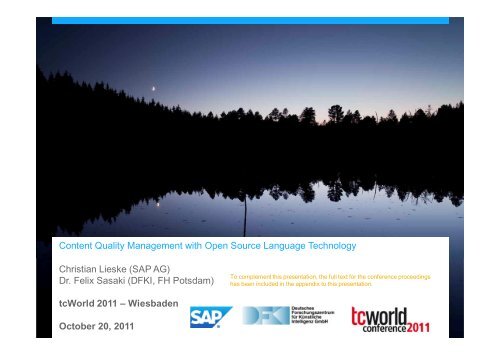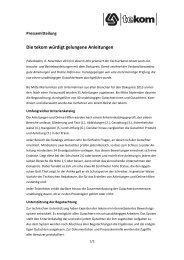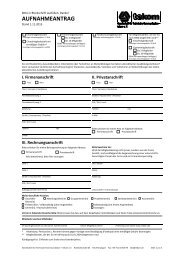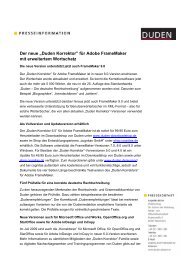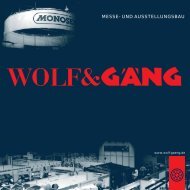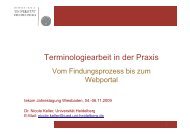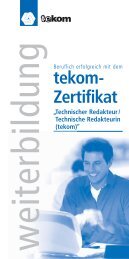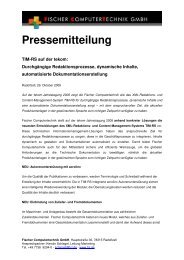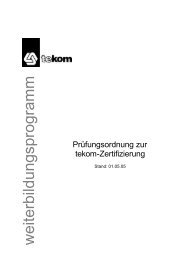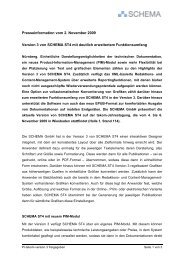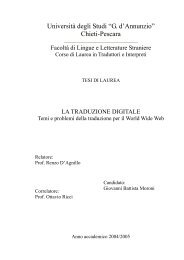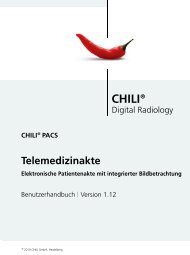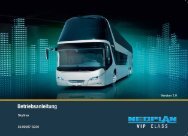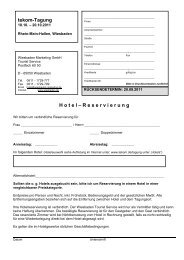Content Quality Management with Open Source Language ... - DFKI
Content Quality Management with Open Source Language ... - DFKI
Content Quality Management with Open Source Language ... - DFKI
You also want an ePaper? Increase the reach of your titles
YUMPU automatically turns print PDFs into web optimized ePapers that Google loves.
<strong>Content</strong> <strong>Quality</strong> <strong>Management</strong> <strong>with</strong> <strong>Open</strong> <strong>Source</strong> <strong>Language</strong> Technology<br />
Christian Lieske (SAP AG)<br />
Dr. Felix Sasaki (<strong>DFKI</strong>, FH Potsdam)<br />
tcWorld 2011 – Wiesbaden<br />
October 20, 2011<br />
To complement this presentation, the full text for the conference proceedings<br />
has been included in the appendix to this presentation.
Authors<br />
Prof. Dr. Felix Sasaki<br />
<strong>DFKI</strong>/FH Potsdam<br />
� Appointed to Prof. in 2009; since 2010<br />
senior researcher at <strong>DFKI</strong> (LT-Lab)<br />
� Head of the German-Austrian W3C-Office<br />
� Before, staff of the World Wide Web<br />
Consortium (W3C) in Japan<br />
� Main field of interest: combined<br />
application of W3C technologies<br />
for representation and processing of<br />
multilingual information<br />
� Studied Japanese, Linguistics and Web<br />
technologies at various Universities in<br />
Germany and Japan<br />
Christian Lieske<br />
Globalization Services<br />
SAP AG<br />
� Knowledge Architect<br />
� <strong>Content</strong> engineering and process<br />
automation (including evaluation,<br />
prototyping and piloting)<br />
� Main field of interest: Internationalization,<br />
translation approaches and natural<br />
language processing<br />
� Contributor to standardization at World<br />
Wide Web Consortium (W3C), OASIS<br />
and elsewhere<br />
� Degree in Computer Science <strong>with</strong> focus<br />
on Natural <strong>Language</strong> Processing and<br />
Artificial Intelligence<br />
2
!<br />
Expectations ?<br />
You expect …<br />
Interaction<br />
Demonstration of a specific format, solution, method or procedure in practice.<br />
An offering related to technical authoring<br />
Get a handle on <strong>Content</strong> <strong>Quality</strong> <strong>Management</strong><br />
A quiet place far away from the fair ;-)<br />
A tutorial designed for the professional level audience<br />
A possibility to talk about your challenges and approaches<br />
Basics of <strong>Language</strong> Technology<br />
That‘s what we expected …<br />
3
Overview<br />
Linguistic <strong>Quality</strong> <strong>Management</strong> and Control for Textual <strong>Content</strong><br />
Basics of Natural <strong>Language</strong> Processing (NLP)/<strong>Language</strong> Technology (LT)<br />
Text Technology<br />
NLP/LT and Text Technology in real world deployment scenarios<br />
NLP/LT and Text Technology in the <strong>Open</strong> <strong>Source</strong> world<br />
Remarks on Basic Due Diligence related to <strong>Open</strong> <strong>Source</strong><br />
Okapi/Rainbow/CheckMate<br />
<strong>Language</strong>Tool<br />
Apache Solr/Apache Lucene<br />
Unstructured Information <strong>Management</strong> Architecture<br />
Conclusion and Outlook<br />
4
WARM UP<br />
5
Dimensions of <strong>Content</strong> <strong>Quality</strong><br />
<strong>Content</strong> is more than text<br />
<strong>Quality</strong> <strong>Management</strong> is more than <strong>Quality</strong> Control<br />
Often more than just linguistic stuff is in the mix<br />
(Natural <strong>Language</strong> Processing vs. Text Technology)<br />
6
Dimensions of Tasks related to Linguistics<br />
Is there existing or new<br />
terminology?<br />
Are spelling, grammar,<br />
and style alright?<br />
Can I recycle an existing<br />
translation?<br />
Should I insert markup of<br />
some kind?<br />
7
Challenge of the Real World (1/3)<br />
8
Challenge of the Real World (2/3)<br />
Human<br />
Actors<br />
Core Processes<br />
<strong>Content</strong> Assets<br />
Tech.<br />
Components<br />
Context<br />
Processes<br />
…<br />
9
Challenge of the Real World (3/3)<br />
Anyone, anything (proprietary, XML ...), anytime<br />
Scaling, consistency, compliance …<br />
Coupling<br />
Object Linking and Embedding, HTTP, Web Services, ...<br />
Libraries/Application Programming Interfaces/Software<br />
Development Kits<br />
Orchestration (e.g. synchronization of calls, and "bus-like"<br />
integration or annotation framework)<br />
10
Adressing the Challenges (1/2)<br />
Best Practices and<br />
Standardization<br />
Computer-Assisted<br />
Linguistic <strong>Quality</strong> Support<br />
Computer-Assisted<br />
Linguistic Assistance<br />
i. Needs assets<br />
ii. Creates assets<br />
iii. Relates to Natural<br />
<strong>Language</strong> Processing<br />
11
Adressing the Challenges (2/2)<br />
W3C Internationalization Tag Set (ITS)<br />
� Fight lacking meta data/lacking<br />
structure<br />
OASIS XML Localization Interchange<br />
File Format (XLIFF)<br />
� Fight format variability<br />
12
Bottomline/Hypothesis<br />
You need Natural <strong>Language</strong> Processing<br />
(NLP)/<strong>Language</strong> Technology (LT) for<br />
quality management related to linguistics.<br />
Text Technology is the base for solid,<br />
sustainable NLP/LT in real world<br />
deployment scenarios.<br />
13
NLP / LT BASICS<br />
14
Linguistic/<strong>Language</strong> Knowledge as Prerequisite<br />
What is the language?<br />
How to avoid explicit encoding for<br />
Omnibusses, Omnibus?<br />
How detect spelling mistake?<br />
15
Lingware – Linguistic/<strong>Language</strong> Knowledge<br />
Input (“resources/assets”) used by the software<br />
Statistical model about relative character frequency � input for<br />
language identification/detection<br />
Flavour depends on approach<br />
Statistical model about translation � statistical Machine<br />
Translation (MT)<br />
Rules for translation � rule-based MT<br />
Combination of both � hybrid MT<br />
Captive approaches<br />
Try to reuse your MT lexicon …<br />
16
Natural <strong>Language</strong> Processing/<strong>Language</strong> Technology<br />
17
Capabilities for Natural <strong>Language</strong> Processing (1/2)<br />
Identify/detect language<br />
“English”<br />
Tokenize<br />
#Text#technology#provides# ...<br />
#����������#�# ...<br />
Stemming<br />
“provides” � “provide”<br />
Detect phrases<br />
#Text technology#<br />
18
Capabilities for Natural <strong>Language</strong> Processing (2/2)<br />
Check (and correct) terminology, spelling, grammar,<br />
style<br />
Text technlogy provide � Text technology provides<br />
Generate<br />
Translations, speech from text, text from speech<br />
Match/Lookup<br />
Against translation memory, term bases, authoring memory<br />
19
Sample Solution – acrolinx iQ<br />
Check spelling,<br />
terminology, grammar,<br />
style<br />
Check preference<br />
expressions<br />
Harvest/extract<br />
terminology (and<br />
preference expressions)<br />
20
TEXT TECHNOLOGY<br />
21
Foundations for Universal Coverage and Efficiency<br />
Think about content <strong>with</strong> the world in mind<br />
Can I encode all characters?<br />
Can my HTML display the content properly?<br />
Can I translate efficiently?<br />
Only world-ready NLP/LT is solid and sustainable<br />
Unicode standard<br />
Allows for content creation and processing in a wide range of languages.<br />
Applied in many contexts (XML, HTML, multilingual Web addresses like http://ja.wikipedia.org/wiki/�<br />
� , etc.)<br />
Unicode support should be considered as a key feature of any NLP/LT offering.<br />
22
Dimensions of Text Technology – Overview<br />
Characters<br />
<strong>Content</strong> formats (e.g. HTML, XML, XML-based vocabularies like DocBook or<br />
DITA, …)<br />
Metadata (e.g. Resource Description Framework)<br />
Filters, e.g. to go from general XML to XLIFF (XML Localization Interchange<br />
File Format) based on W3C Internationalization Tag Set (ITS)<br />
…<br />
23
Dimensions of Text Technology – Standards<br />
Assets<br />
Terminology – TermBase eXchange (TBX)<br />
Former Translations – Translation Memory<br />
eXchange (TMX)<br />
Canonicalized <strong>Content</strong><br />
XML Localization Interchange File Format<br />
(XLIFF)<br />
Resource Descriptions<br />
Internationalization Tag Set (ITS)<br />
24
OKAPI / RAINBOW /<br />
CHECKMATE<br />
25
Okapi – Overview<br />
<strong>Open</strong> <strong>Source</strong> set of components and applications to build new or enhance existing<br />
content-related processes<br />
Helps to analyze, fix, convert, package, check quality … chain and couple<br />
Implements <strong>Open</strong> Architecture for XML Authoring and Localization Reference Model<br />
(OAXAL)<br />
Roots and strengths in localization and translation<br />
Uses and promotes open standards where possible<br />
Various usage options<br />
26
Okapi – Framework to Build Interoperable Tools<br />
Filters<br />
Connectors (TM,<br />
MT, etc.)<br />
Applications, Tools,<br />
Scripts<br />
Steps<br />
Other Components<br />
(Segmenter,<br />
Tokenizer, etc.)<br />
Core Libraries (Resource model, Event model,<br />
APIs, Annotations, etc.)<br />
27
Okapi – Usage Options (Explanation)<br />
Stand-alone via GUI<br />
Embedded (e.g. in batch processing server) as Java<br />
library<br />
Coupled as HTTP-accessible server<br />
From command line<br />
28
Okapi – Some Out-of-the Box Usage Options (Demo)<br />
.dita and .xml<br />
UI/Rainbow<br />
Get overview of XML (used characters<br />
and markup)<br />
Transform XML<br />
Search and replace (<strong>with</strong> and <strong>with</strong>out filter; � )<br />
Command Line/Tikal<br />
"okapi-apps_win32-x86_64_0.14\startTikalPrompt.bat"<br />
tikal -trace -x -ie UTF-8 dita.xml<br />
29
Rainbow / CheckMate – Overview<br />
Rainbow<br />
Text extraction and merging<br />
Character encoding conversion<br />
Term extraction<br />
File format conversion<br />
<strong>Quality</strong> verification<br />
Translation comparison<br />
Pseudo-translation<br />
…<br />
CheckMate<br />
<strong>Quality</strong> checks on bilingual translations e.g. on XLIFF and TMX files<br />
30
Okapi – Advanced Out-of-the Box Usage Options (Demo)<br />
Extract term candidates<br />
Generate XLIFF for arbitrary XML<br />
tikal -trace -x -ie UTF-8 its-example.xml<br />
Create ITS rules<br />
tikal -trace -x -fc okf_xml@tcWorld-its -ie UTF-8 its-example.xml<br />
Pseudo-translate XLIFF<br />
Check translated XLIFF<br />
Mismatch in number of inline tags<br />
31
LANGUAGETOOL<br />
32
<strong>Language</strong>Tool – Overview<br />
<strong>Open</strong> <strong>Source</strong> style and grammar checker (no spell checker)<br />
English, French, German, Polish, Dutch, Romanian, and other<br />
languages<br />
Only knows about errors – not about correct language (rules describe<br />
errors)<br />
Based on NLP/LT (stemming, morphological analysis, part-of-speech<br />
tagging)<br />
Various usage options<br />
33
<strong>Language</strong>Tool – Usage Options (Explanation)<br />
Embedded (e.g. in <strong>Open</strong>Office/LibreOffice)<br />
Stand-alone via GUI<br />
Stand-alone via system tray<br />
Embedded as Java library<br />
Coupled as HTTP-accessible service (e.g. from Okapi tools)<br />
Via output in XML-based format<br />
34
<strong>Language</strong>Tool – Some Out-of-the Box Usage Options (Demo)<br />
Duplicated words …<br />
UI/Stand-alone Editor<br />
java -jar <strong>Language</strong>ToolGUI.jar<br />
Clipboard “Listener”<br />
Command Line<br />
java -jar <strong>Language</strong>ToolGUI.jar –tray<br />
java -jar <strong>Language</strong>Tool.jar -l en -v -b -<br />
35
<strong>Language</strong>Tool – Checking and Capabilities<br />
Correct the text directly (rather than only displaying<br />
messages and possibly suggestions)<br />
Special mechanisms for coherency checks, and false<br />
friends (mother tongue different from text language)<br />
Bitext mode (allows checks like length and identity,<br />
copy syntax patterns)<br />
36
<strong>Language</strong>Tool – Customization (Explanation)<br />
Rules encoded in XML configuration files (easy-to-write,<br />
and easy-to-read)<br />
Rules written in Java (require programming know-how,<br />
more powerful)<br />
Adaptation of existing non-XML resources (e.g.<br />
additions to the lexicon)<br />
Inclusion of processing for additional languages<br />
37
<strong>Language</strong>Tool – Basic Customization (Demo)<br />
rules\de\grammar.xml<br />
38
<strong>Language</strong>Tool – Advanced Usage Option (Demo)<br />
Server called via Rainbow / CheckMate<br />
java -cp <strong>Language</strong>Tool.jar de.danielnaber.languagetool.server.HTTPServer<br />
39
<strong>Language</strong>Tool – Possible Additional Demos<br />
More grammar/syntax rules related to simple language<br />
java -jar <strong>Language</strong>Tool.jar -l de -c UTF-8 -v -b -a tests\tcWorld-Fehler-deDE.txt<br />
java -jar <strong>Language</strong>Tool.jar -l en -c UTF-8 --api -b tests\tcWorld-abstract-enUS.txt ><br />
tests\output.xml<br />
40
LUCENE / SOLR<br />
41
Apache Solr – Overview<br />
<strong>Open</strong> source full text search server<br />
Built around the Lucene full text indexing system<br />
Can handle input documents in various formats via built-in Tika toolkit<br />
PDF, XML, doc, docx, …<br />
Metadata from images, audio, video<br />
See list of supported formats at http://tika.apache.org/0.10/formats.html<br />
Proven robustness and high performance<br />
Configuration via XML files – no programming needed<br />
Modules for a large number of languages (see http://wiki.apache.org/solr/<strong>Language</strong>Analysis for an<br />
overview)<br />
42
Apache Solr – Processing Concept<br />
Input XML, JSON,<br />
PDF, Word, …<br />
Output<br />
Index the<br />
input<br />
(parameters<br />
such as stop<br />
words)<br />
Use<br />
Query the index<br />
Via web<br />
mechanisms (that is:<br />
HTTP)<br />
Results in various<br />
formats (e.g. XML or<br />
JSON)<br />
43
Apache Solr – Sample <strong>Quality</strong> Assurance Use<br />
Via XML<br />
configuration file,<br />
define userenhanced<br />
list of<br />
French stop words<br />
Index corpus<br />
Fire of queries to<br />
detect unalloweded<br />
terms<br />
44
Solr – Canned Demo (Set up)<br />
Install Solr<br />
http://lucene.apache.org/solr/index.html#getstarted<br />
(needs Java 1.6)<br />
<strong>Open</strong> your browser at http://localhost:8983/solr/<br />
45
Solr – Canned Demo (Add Files via HTTP)<br />
Example URI (e.g. for use <strong>with</strong> cURL tool)<br />
http://localhost:8983/solr/update/extract?<br />
literal.id=doc1&<br />
uprefix=attr_&<br />
fmap.content=my_content_de<br />
&commit=true" -F "myfile=@tutorial.pdf"<br />
Explanation<br />
Add tutorial.pdf to the index<br />
Use the field my_content_de (defined in schema.xml)<br />
ID of the document in the index: doc1<br />
46
Solr – Canned Demo (Add Files via Shell Script)<br />
Input is a directory name<br />
Files <strong>with</strong> specific endings are processed<br />
Field for indexing is specified in the script – here attr_content<br />
47
Solr – Canned Demo (Query 1)<br />
Get a list of the<br />
50 most frequently<br />
used terms<br />
http://localhost:8983/solr/terms?<br />
terms.fl=attr_content&<br />
terms.sort=count&<br />
terms.limit=50<br />
48
Solr – Canned Demo (Query 2)<br />
Search for a specific term and get<br />
documents that contain it<br />
http://localhost:8983/solr/select?<br />
&q=attr_content<br />
:ArabicNormalizationFilterFactory<br />
49
Solr – Canned Demo (Highlight Terms in Context)<br />
50
Solr – Canned Demo (Advanced Use – Configure via<br />
schema.xml)<br />
Define “fieldtypes” (and fields making use of fieldtypes) for indexing and query, e.g. language-specific<br />
Example for indexing:<br />
1<br />
2<br />
3<br />
Use standard tokenizing<br />
Reference (your) stop words<br />
Convert to lower case<br />
51
Solr – Canned Demo (<strong>Language</strong> Technology Components)<br />
General components<br />
http://wiki.apache.org/solr/AnalyzersTokenizersTokenFilters<br />
<strong>Language</strong> specific components<br />
http://wiki.apache.org/solr/<strong>Language</strong>Analysis<br />
52
Solr – Canned Demo (field and fieldtype for German)<br />
<br />
…<br />
<br />
<br />
<br />
<br />
<br />
<br />
<br />
<br />
<br />
<br />
<br />
Solr – Final Remarks<br />
Provides many basic LT processing modules, including language<br />
specific tasks<br />
Example: Tokenizer for Chinese, Japanese, Korean based on statistical model (n-gram)<br />
<strong>Quality</strong> is not always good<br />
Pipelines architecture of Solr allows to plug in better, alternative<br />
modules<br />
Example: Better morphological analysis and word segmentation for Chinese, Japanese<br />
and Korean<br />
Unfortunately, alternative modules are often commercial and<br />
expensive<br />
54
UIMA<br />
55
UIMA – Overview<br />
NLP/LT often needs to analyze unstructured (textual) content in various steps (language<br />
identification, tokenization, segmentation, …)<br />
Need for tying together and orchestrating processing components<br />
The “Unstructured Information <strong>Management</strong> Architecture” (UIMA) is an architecture for<br />
defining and combining components related to the processing of unstructured information<br />
Not a piece of running software<br />
Helps to design processing pipelines (to ease integration efforts and enhance<br />
interoperability)<br />
Recently UIMA became famous via the Watson text analysis system<br />
56
UIMA – Usage Scenario<br />
Couple Solr <strong>with</strong> the Alchemy API (allows among others for advanced language<br />
identification or named entity extraction)<br />
Details: http://wiki.apache.org/solr/SolrUIMA<br />
57
CONCLUSION AND OUTLOOK<br />
58
Conclusions and Outlook<br />
Linguistic quality assurance based on NLP/LT is a reality.<br />
The use of standards and best practices originating in text technology, frameworks<br />
for processing pipelines, and open source offerings put it into reach for new<br />
constituencies such as small enterprises.<br />
The open source community, as well as stewards of standards and inclusion – such<br />
as the World Wide Web Consortium (W3C), and the European Commission (EC) –<br />
continue their support for easily accessible multilingual content. Two examples are<br />
the EC-funded, and W3C-coordinated Thematic Network “Multilingual Web” (see<br />
http://www.multilingual-web.eu) and the forthcoming MultilingualWeb-LT project.<br />
59
Thank You!<br />
Contact information:<br />
Christian Lieske<br />
christian.lieske@sap.com<br />
www.sap.com<br />
Felix Sasaki<br />
felix.sasaki@dfki.de<br />
www.dfki.de<br />
The authors would like to thank Daniel Naber and Yves Savourel for reviewing draft versions of this presentation.<br />
The copyrighted picture of a lake (maybe a symbol of purity) on the first slide is courtesy of Dr. Peter Gutsche (www.silberspur.de).<br />
60
Disclaimer<br />
All product and service names mentioned and associated logos displayed are the trademarks of their respective companies. Data contained in this document serves informational purposes<br />
only. National product specifications may vary.<br />
This document may contain only intended strategies, developments, and is not intended to be binding upon the authors or their employers to any particular course of business, product<br />
strategy, and/or development. The authors or their employers assume no responsibility for errors or omissions in this document. The authors or their employers do not warrant the accuracy<br />
or completeness of the information, text, graphics, links, or other items contained <strong>with</strong>in this material. This document is provided <strong>with</strong>out a warranty of any kind, either express or implied,<br />
including but not limited to the implied warranties of merchantability, fitness for a particular purpose, or non-infringement.<br />
The authors or their employers shall have no liability for damages of any kind including <strong>with</strong>out limitation direct, special, indirect, or consequential damages that may result from the use of<br />
these materials. This limitation shall not apply in cases of intent or gross negligence.<br />
The authors have no control over the information that you may access through the use of hot links contained in these materials and does not endorse your use of third-party Web pages nor<br />
provide any warranty whatsoever relating to third-party Web pages.<br />
61
Full Text of the Conference Proceedings<br />
62
<strong>Content</strong> <strong>Quality</strong> <strong>Management</strong> <strong>with</strong> <strong>Open</strong> <strong>Source</strong> <strong>Language</strong> Technology<br />
Christian�Lieske,�SAP�AG;�Felix�Sasaki,�<strong>DFKI</strong>/FH�Potsdam�<br />
Overview<br />
��<br />
Today’s�content�production�is�high�paced.�In�addition,�it�is�demanding�in�terms�of�quality�<br />
and�cost�efficiency.�Furthermore,�it�is�distributed�amongst�many�parties�and�challenging�<br />
due�to�vast�volumes.�Accordingly,�quality�management�and�quality�control�related�<br />
especially�to�textual�content�is�in�desperate�need�of�automation.�Promising�automation�<br />
solutions�related�to�the�linguistic�quality�of�mono-�or�multilingual�textual�content�rely�on�<br />
Natural�<strong>Language</strong>�Processing�(NLP)/<strong>Language</strong>�Technology�(LT).�In�order�to�deploy�<br />
NLP/LT�in�real�world�scenarios,�these�scenarios�need�to�be�seamlessly�coupled�<strong>with</strong>,�or�<br />
integrated�into�content�production�process�chains.�<br />
�<br />
�This�text�����complement�to�the�corresponding�tutorial�at�the�tcWorld�2011���starts�<br />
<strong>with</strong>�an�overview�of�typical�linguistic�quality�tasks�related�to�textual�content.�Afterwards�<br />
��following���short�explanation�of�general�NLP/LT�concepts���it�sketches�NLP/LT�for�<br />
linguistic�quality�tasks.�As���basis�for�sustainable�and�solid�NLP/LT,�so-called�Text�<br />
Technology�is�being�surveyed.�The�text�then�moves�on�to�observations�related�to�the�use�<br />
of�NLP/LT�in�real�world�deployment�scenarios.�<br />
�<br />
The�concepts�are�exemplified�based�on�the�reality�in�some�technical�communications�<br />
environments�<strong>with</strong>�open�source�offerings.�In�order�to�allow�for�easy�follow-up,�the�<br />
demonstrations�use�open�source�technology.�Some�tasks�use�examples�from�the�realm�of�<br />
language-related�requirements�related�to�accessibility�(sometimes�referred�to�as�<br />
easy/simple�language).�<br />
��<br />
Linguistic <strong>Quality</strong> <strong>Management</strong> and Control for Textual <strong>Content</strong><br />
��<br />
For�the�purpose�of�this�text,���distinction�is�made�between�two�different�dimensions�of�<br />
quality�management�and�control�for�textual�content�(samples�are�drawn�from�Webrelated�content�such�as�HTML�pages):�<br />
��<br />
a. Technical���Characters�are�displayed�properly,�markup�is�adequate,�links�are�<br />
correct�<br />
b. Linguistic���Spelling,�grammar,�style,�and�terminology�are�immaculate�<br />
��<br />
��closer�look�at�the�linguistic�dimension�shows�that�it�encompasses�two�quite�different�<br />
areas:�general�information�processing�on�the�one�hand,�and�linguistic�assistance�on�the�<br />
other�hand.�Information�processing�often�is�tied�to�the�initial�creation�of�resources�(e.g.�<br />
databases�related�to�terminology,�text�chunks,�or�existing�translations)�whereas�<br />
linguistic�assistance�is�mainly�encountered�during�the�actual�creation�of�textual�content�<br />
(which�of�course�often�relates�to,�or�adapts�aforementioned�existing�resources�such�as�<br />
termbases,�authoring�memories,�or�translation�memories).�Example�activities�and�usage�<br />
scenarios�in�both�areas�are�the�following:�<br />
��<br />
a. Information�Processing�(search,�extract,�or�enhance;�create�resources)�<br />
��
��<br />
��<br />
- Generate���monolingual�list�of�term�candidates�<br />
- Align�two�monolingual�texts�(e.g.�German�and�French)�to�fill���translation�<br />
memory�<br />
- Identify�phone�numbers,�addresses�etc.�in�order�to�tag�them�<strong>with</strong>�special�<br />
markup��<br />
b. Linguistic�Assistance�(propose�and�check;�help�to�author�or�translate�efficiently�<br />
and�properly)�<br />
- Suggest���possibly�alternative���wording�(based�for�example�on�entries�in�<br />
termbases,�or�authoring/translation�memories)�<br />
- Check���and�possibly�automatically�correct���texts�against�rules�for�spelling,�<br />
terminology,�grammar,�or�specific�style�rules�(e.g.�company-proprietary�<br />
guidelines)�<br />
- Transfer/translate�text���either�by�reusing�and�possibly�adapted�(subsegment)�strings,�or�generating�via�Machine�Translation���from���source�<br />
language�to���target�language�<br />
�<br />
In�the�realm�of�technical�communications,�very�often�four�roles�come�into�play�in�the�<br />
aforementioned�activities:�<br />
�<br />
� Authors�want�interactive�assistance�for�creating�of�correcting�texts�<br />
� Managers�like�to�see�numbers�(e.g.�quality�indicators�based�on�the�number�of�<br />
errors�calculated�by���tool)�and�want�to�use�them�in�analytical�applications�<br />
� Solution�architects,�terminologists�and�translators�create�resources�(e.g.�<br />
termbases�and�formalized�style�rules),�technical�components,�and�processing�<br />
pipelines��<br />
� Translators�want�to�match�against�termbases�and�translation�memories�<br />
��<br />
Basics of Natural <strong>Language</strong> Processing (NLP)/<strong>Language</strong> Technology (LT)<br />
��<br />
Automation�related�to�the�linguistic�tasks�mentioned�above�usually�needs�to�go�beyond�<br />
simple�strings�processing�approaches�like�the�use�of�regular�expressions.�In�one�shape�<br />
or�other,�linguistic�knowledge�����model�of�the�language�at�hand���is�needed.�This�is�the�<br />
focus�of�Natural�<strong>Language</strong>�Processing�(NLP)/<strong>Language</strong>�Technology�(LT).�To�be�specific,�<br />
NLP/LT�most�often�comprises�two�main���very�often�intertangled���ingredients�(the�<br />
details�provided�are�just�examples):�<br />
��<br />
a. Software,�that�is�components�for�<br />
��<br />
- Identifying�the�language�in�which���text�is�written�<br />
- Applying�tokenization�rules�(which�break�strings�up�into�entities�such�as�<br />
words)�<br />
- Stemming�or�analyzing�morphologically�(which�determine�base�forms,�or�<br />
sub-entities�of���compound�expression)�<br />
- Applying�segmentation�rules�(which�break�documents�up�into�entities�such�<br />
as�sentences)�<br />
- Computing�relationships�between�entities�(e.g.�one�that�groups�words�into�<br />
entities�such�as�nominal�phrases�"Radio�Frequency")�
��<br />
- Comparing���given�spelling�to���model�that�encodes�the�correct�spelling�<br />
- Correcting�an�incorrect�grammatical�structure�according�to���model�that�<br />
encodes�the�correct�grammar�<br />
- Generating�translations�<br />
- Covering�special�communication�modalities�(e.g.�spontaneous�speech)�<br />
- Matching�against�resources�such�as�termbases,�authoring�memories�or�<br />
translation�memories�<br />
b. Lingware,�that�is�formalized�linguistic�knowledge�such�as�<br />
��<br />
- ��statistical�model�that�encodes�the�relatively�frequency�of���certain�<br />
characters�in���language�(or�script);�can�be�used�for�language�identification�<br />
- ��set�of�rules�that�model�multiword�phrases;�can�be�used�to�generate�term�<br />
candidates�<br />
- ��set�of�mathematical�properties�(e.g.�bi-�or�trigrams�of�part-of-speech�tags)�<br />
that�capture�syntactic�features;�can�be�used�to�detect�grammar�errors�<br />
- ��lexicon�that�captures�so-called�lemmatas�and�features�(such�as�their�<br />
inflection�paradigm);�can�be�used�for�machine�translation�<br />
��<br />
As�indicated�above,�lingware�pertains�to�different�entities�(e.g.�characters,�<br />
words/tokens/ideographs,�syntactic�structures,�...)�and�comes�in�two�categories:�<br />
statistical�or�symbolic.�In�case�the�two�categories�are�combined,�the�corresponding�<br />
offerings�often�are�termed�"hybrid"�(e.g.�"hybrid�Machine�Translation").�<br />
��<br />
Very�often�you�will�see���separation�of�lower�level�NLP/LT�(e.g.�tokenizer,�part-of-speech�<br />
tagger,�...)�and�higher�level�(term�candidate�extractor,�spell�checker,�grammar�checker,�<br />
...).�The�higher�level�NLP/LT�is�what�ordinary�users�get�to�see.�<br />
��<br />
In�today's�world,�NLP/LT�most�often�starts�<strong>with</strong>�an�analysis�of�text.�Only�after�the�<br />
analysis,�possibly���generation�of�text�(e.g.���correction�suggestion)�is�triggered.���simple�<br />
approach�to�generation�works�<strong>with</strong>�templates�(where�no�syntactic�structures�are�<br />
generated,�but�only�gaps�are�filled�in���fill-in-the-blank�fashion).�<br />
��<br />
Tools�that�are�categorized�as�"computer�assisted�authoring/translation"�often�include�<br />
approaches�that�originate�in�NLP/LT.�At�least�initially,�the�focus�of�these�tools,�however,�<br />
relates�to�the�creation�and�reuse�of�special�purpose�assets�(such�as�the�term�candidates,�<br />
bilingual�translated�segments,�or�aligned�translated�documents�of�an�individual�<br />
translator�or���whole�company).�<br />
��<br />
Text Technology<br />
�<br />
"Text�technology"�is�the�foundation�for�solid�and�sustainable�NLP/LT�applications.�An�<br />
example�for�text�technology�is�the�Unicode�standard.�It�is�being�applied�in�many�contexts�<br />
(XML,�HTML,�multilingual�Web�addresses�like�http://ja.wikipedia.org/wiki/�����etc.)�<br />
and�allows�for�content�creation�and�processing�in���wide�range�of�languages.�Thus,�<br />
Unicode�support�should�be�considered�as���key�feature�of�any�NLP/LT�offering.�In���<br />
sense,�text�technology�embodies�rules�(e.g.�for�the�syntax�of���markup�language),�and�<br />
best�practices�related�to�many�sub-domains�(e.g.�character�encoding)�<strong>with</strong>in�NLP/LT.�<br />
�
Text�technology�provides�answers�not�only�related�to�characters,�but�also�to�other�areas:��<br />
�<br />
� <strong>Content</strong>�(e.g.�HTML,�XML,�XML-based�vocabularies�like�DocBook�or�DITA,�…)��<br />
� Metadata�(e.g.�Resource�Description�Framework)�<br />
� Filters,�e.g.�to�go�from�general�XML�to�XLIFF�(XML�Localization�Interchange�<br />
File�Format)�based�on�W3C�Internationalization�Tag�Set�(ITS)�<br />
� ��<br />
�<br />
Although�text�technology�thus�is�vital�for�real-world�deployment�of�NLP/LT,�it�is�often�<br />
neglected.�Example:�Instead�of�reusing�an�existing�vocabulary,�simply���new,�proprietary�<br />
one�is�created.�Luckily,�however,�more�and�more�projects�and�offerings�are�dedicated�to�<br />
the�integration�of�text�technology�<strong>with</strong>�NLP/LT.�One�example�is�the�m4loc�project�<br />
http://code.google.com/p/m4loc/���It�aims�at�integrating�the�statistical�machine�<br />
translation�engine�Moses�<strong>with</strong>�XLIFF�based�localization�workflows.�<br />
��<br />
NLP/LT and Text Technology in real world deployment scenarios<br />
��<br />
��typical�task�related�to�linguistic�quality�control�usually�requires�that�several�<br />
capabilities/tools/components�are�seamlessly�integrated�into�each�other.���content�<br />
production�process�may�for�example�require�the�following�sequence�of�activities�(all�of�<br />
which�relate�to�primary�goals�such�as�superb�user�experience,�and�legal�compliance):�<br />
��<br />
a. Find���special�purpose�format�object�such�as�an�image�represented�as�Scalable�<br />
Vector�Graphics�(SVG)�in���<strong>Content</strong>�<strong>Management</strong>�System�(CMS)�<br />
b. Convert�the�SVG�file�into�more�"linguistic�friendly"�XML�(e.g.�XML�Localization�<br />
Interchange�File�Format;�XLIFF)�<br />
c. Check�the�content�of�the�XLIFF�file�for�unallowed�terms�(either�source�language,�<br />
target�language�or�both;�based�on���termbase�that�lists�unallowed�and�allowed�<br />
terms)�<br />
d. Submit�the�checking�result�into���Business�Intelligence�solution�(e.g.�for�reporting�<br />
purposes)�<br />
��<br />
Accordingly,�real�world�deployment�scenarios�need�to�answer�questions�related�to�<br />
integration�approaches,�and�thus�need�to�be�concerned�<strong>with</strong>�areas�such�as�the�following:�<br />
��<br />
a. Formats�(proprietary,�Java�Script�Object�Notation,�XML,�XLIFF,�...)�<br />
b. Coupling�(Object�Linking�and�Embedding,�HTTP,�Web�Services,�...)�<br />
c. Libraries/Application�Programming�Interfaces/Software�Development�Kits�<br />
d. Orchestration�(e.g.�synchronization�of�calls,�and�"bus-like"�integration�or�<br />
annotation�framework)�<br />
��<br />
NLP/LT and Text Technology in the <strong>Open</strong> <strong>Source</strong> world<br />
Remarks on Basic Due Diligence related to <strong>Open</strong> <strong>Source</strong><br />
�<br />
Before�working�<strong>with</strong>�open�source�offerings,�questions�such�as�the�following�should�be�<br />
addressed:��<br />
��<br />
a. Is�this�project�still�alive?���Look�at�last�version,�reported�bugs,�fixes�etc.�
��<br />
b. What�am���allowed�to�do?���Look�at�license/license�conditions�<br />
c. Is�this���solid/quality�endeavor?���Look�at�mailing�lists�etc.�<br />
d. In�which�languages�are�the�User�Interface,�and�User�Assistance/Documentation�<br />
provided?�<br />
e. What�is�the�quality�of�the�documentation?�Do�additional�books�exist?�<br />
f. Which�interfaces/connectors/exchange�formats�are�supported?�<br />
g. Is�the�technology�behind�mainstream�(or�is�for�example�the�programming�<br />
language�one�that�is�almost�unknown)?�<br />
h. What�might�be�the�unique�selling�proposition�of�commercial�offerings?���Look�for�<br />
details�such�as�supported�languages,�accuracy,�quotes�from�reference�customers�<br />
Okapi/Rainbow/CheckMate<br />
�<br />
Linguistic�<strong>Quality</strong>�<strong>Management</strong>�can�only�be�successful�if�it�is�seamlessly�integrated�into�<br />
an�overall�content�production�chain.�Accordingly,�there�is�very�often���need�to�“massage”�<br />
content�(e.g.�to�convert�it),�or�to�have�content�flow�from�one�processing�component�to�<br />
another�one.�<br />
�<br />
“The�Okapi�Framework�is���cross-platform�and�free�open-source�set�of�components�and�<br />
applications�allows�process�architects�to�build�new�content-related�processes�or�<br />
enhance�existing�ones�while�preserving�compatibility�and�interoperability.�The�<br />
framework�has�its�roots�and�strengths�in�processes�and�tasks�related�to�localization�and�<br />
translation.�Whenever�possible,�the�project�uses�and�promotes�open�standards.��<br />
�<br />
Rainbow�is�an�Okapi-based�GUI�application�to�launch�various�utilities�such�as:�Text�<br />
extraction�(to�XLIFF,�OmegaT�projects,�RTF,�etc.)�and�merging,�encoding�conversion,�<br />
terms�extraction,�file�format�conversions,�quality�verification,�translation�comparison,�<br />
search�and�replace�on�filtered�text,�pseudo-translation,�and�much�more.�Using�the�<br />
framework's�pipeline�mechanism,�you�can�use�Rainbow�to�create�chains�of�steps�that�<br />
perform�specific�set�of�tasks�specific�to�your�needs.�CheckMate�is�an�Okapi-based�GUI�<br />
application�that�performs�various�quality�checks�on�bilingual�translation�files�such�as�<br />
XLIFF,�TMX.”�(adapted�from�http://okapi.opentag.com/).��<br />
�<br />
Usage�scenarios�covered�during�the�tutorial:�<br />
�<br />
� Used�characters�listing�<br />
� Term�extraction�<br />
� Conversion�from�proprietary�XML�to�XLIFF�based�on�W3C�ITS�<br />
� ��<br />
�<br />
<strong>Language</strong>Tool<br />
�<br />
<strong>Language</strong>Tool��is�an�<strong>Open</strong>�<strong>Source</strong>�style�and�grammar�checker�for�English,�French,�<br />
German,�Polish,�Dutch,�Romanian,�and�other�languages.�It�does�not�include�spell�<br />
checking.�<strong>Language</strong>Tool,�however,�can�be�used�for�tasks�related�to�terminology�control�<br />
(adapted�from�http://www.languagetool.org/).��<br />
�<br />
<strong>Language</strong>Tool�is�based�on�NLP/LT�concepts�such�as�stemming�and�morphological�<br />
analysis,�and�part-of-speech�(POS)�tagging.�It�can�be�used�out-of-the-box.�In�addition,�
however,�it�is���framework�for�building�language�processing���in�particular�language�<br />
quality�assurance���applications.�<br />
�<br />
<strong>Language</strong>Tool�only�knows�about�errors���not�about�correct�language.�All�rules�describe�<br />
errors.�<br />
�<br />
Important�features�of�<strong>Language</strong>Tool�are�the�following:�<br />
�<br />
1. Various�customization�options�<br />
�<br />
- Rules�encoded�in�XML�configuration�files�(easy-to-write,�and�easy-to-read)�<br />
- Rules�written�in�Java�(require�programming�know-how,�more�powerful)�<br />
- Adaptation�of�existing�non-XML�resources�(e.g.�additions�to�the�lexicon)�<br />
- Inclusion�of�processing�for�additional�languages�<br />
�<br />
2. Solid�foundation�for�use�and�connectivity�<br />
�<br />
- Embedded�(e.g.�in�<strong>Open</strong>Office/LibreOffice)�<br />
- Stand-alone�via�GUI�<br />
- Stand-alone�via�system�tray�<br />
- Embedded�as�Java�library�<br />
- Coupled�as�HTTP-accessible�service�(e.g.�from�Okapi�CheckMate)�<br />
- Via�output�in�XML-based�format�<br />
�<br />
3. Checking�and�correction�capabilities�<br />
�<br />
- Correct�the�text�directly�rather�than�only�displaying�messages�and�possibly�<br />
suggestions�<br />
- Special�mechanisms�for�coherency�checks,�and�false�friends�(mother�tongue�<br />
different�from�text�language)�<br />
- Bitext�mode�that�allows�checks�like�length�and�identity,�copy�syntax�patterns�<br />
�<br />
Usage�scenarios�covered�during�the�tutorial:�<br />
�<br />
� Out-of-the�box�rules�<strong>with</strong>�various�interfaces�(e.g.�UI)�<br />
� Various�grammar/syntax�rules�related�to�simple�language�<br />
� Term�checking�(possibly�bilingual)�<br />
�<br />
Tips&Tricks�that�might�be�mentioned:�<br />
�<br />
� Inflection/deinflection�only�possible�if�known�(to�Morphy�for�German)�<br />
� Names�only�used�in�configuration/rule�selection�dialogue�<br />
� XML�entities�can�be�used�to�ensure�consistent�messages�<br />
� Example�can�be�used�for�unit�testing�(testrules.bat)�<br />
� Additional�rules�can�even�be�loaded�via�WebStart�<br />
� Coherence�rules�(implemented�in�Java)�help�to�ensure�proper�terminology�<br />
��<br />
Advanced�Topics�that�might�be�touched�upon:�<br />
�<br />
� Rule�for���(use�of�decomposition)�
��<br />
Apache Solr/Apache Lucene<br />
��<br />
Apache�Solr�is�an�open�source�full�text�search�server,�built�around�the�Lucene�full�text�<br />
indexing�system.�Solr’s�processing�concept�is�simple:�<br />
�<br />
a. You�put�documents�in�various�formats�(XML,�JSON,�PDF,�Word,�...)�in;�extraction�<br />
is�performed�via�http://tika.apache.org/.�Tika�plays�an�important�role�in���<br />
couple�of�extraction�and�roundtripping�scenarios�(e.g.�in�the�Moses4Localization�<br />
project).��<br />
b. Solr�creates�an�index�for�the�documents;�you�can�fine�tune�the�indexing�via�<br />
parameters�such�as�stop�words�<br />
c. You�query�the�documents/search�the�index�via�the�Web�mechanisms�(that�is:�<br />
HTTP)�and�receive�the�result�in�various�formats�(e.g.�XML�or�JSON)�<br />
�<br />
Besides�its�robustness�and�high�performance,�key�feature�of�Solr�relevant�for�"linguistic�<br />
quality�assurance"�are�the�following:�<br />
�<br />
� Configuration�based�on�XML�file���no�programming�is�needed.��<br />
Example:�In�an�XML�configuration�file,���field�is�defined�that�can�be�used�for�<br />
indexing�of�French�text.�This�definition�related�to���user-enhanced�list�of�stop�<br />
words�<br />
�<br />
� Modules�for���large�number�of�languages�(see�<br />
http://wiki.apache.org/solr/<strong>Language</strong>Analysis��for�an�overview)���allows�for�<br />
fulfilling�the�"linguistic�quality�assurance"�task�in���multilingual�fashion�(e.g.�via�<br />
checks�against�lists�of�unallowed�terms)�<br />
��<br />
An�example�technical�communications�usage�scenario�for�Solr:��<br />
�<br />
You�may�have�to�assure�that�only�allowed�terms�are�used�in���large�body�of�text.�<br />
Solr�indexes�your�texts.�Once�Solr�has�created�the�index,�you�do�your�term�checks�<br />
against�Solr’s�index.�This�approach�may�reduce�the�time�that�is�needed�for�your�<br />
checks�down�from�several�hours�to�several�minutes.�<br />
�<br />
Unstructured Information <strong>Management</strong> Architecture<br />
�<br />
NLP/LT�often�needs�to�analyze�unstructured�(textual)�content�in�various�steps�<br />
(language�identification,�tokenization,�segmentation,�…).�Thus,�there�is���need�for�tying�<br />
together�and�orchestrating�processing�components.�<br />
�<br />
The�“Unstructured�Information�<strong>Management</strong>�Architecture”�(UIMA)�is���framework�for�<br />
defining�and�combining�components�related�to�the�processing�of�unstructured�<br />
information.�Recently�UIMA�became�famous�via�the�Watson�text�analysis�system���the�<br />
system�(which�is�based�on�UIMA)�won���Jeopardy�competition�against�several�"human"�<br />
Jeopardy�stars.�<br />
�<br />
Unlike�Okapi/Rainbow/CheckMate,�<strong>Language</strong>�Tool�or�Solr,�UIMA�is�not���framework�to�<br />
use�"as�is".�The�UIMA�framework�itself�provides�no�ready�to�use�filters,�language�
checkers,�indexing�components,�or�the�like.�UIMA�rather�helps�to�design�processing�<br />
pipelines.�Furthermore,�UIMA�eases�integration�efforts�and�enhances�interoperability�<br />
since�it�outlines�interfaces�between�components/pipelines�steps.�Example:�Using�UIMA�<br />
(see�http://wiki.apache.org/solr/SolrUIMA��Solr�can�be�easily�coupled�e.g.�<strong>with</strong>�the�<br />
Alchemy�API,�which�allows�among�others�for�advanced�language�identification�or�named�<br />
entity�extraction.��<br />
��<br />
Conclusion and Outlook<br />
�<br />
Linguistic�quality�assurance�based�on�NLP/LT�is���reality.�The�use�of�standards�and�best�<br />
practices�originating�in�text�technology,�frameworks�for�processing�pipelines,�and�open�<br />
source�offerings�put�it�into�reach�for�new�constituencies�such�as�small�enterprises.�<br />
�<br />
The�open�source�community,�as�well�as�the�stewards�of�standards�and�inclusion���such�<br />
as�the�World�Wide�Web�Consortium�(W3C)�and�the�European�Commission�(EC)���<br />
continue�their�support�for�easily�accessible�multilingual�content.�Two�examples�are�the�<br />
EC-funded,�and�W3C-coordinated�Thematic�Network�“Multilingual�Web”�(see�<br />
http://www.multilingual-web.eu��and�the�forthcoming�MultilingualWeb-LT�project.�<br />
��<br />
Appendix<br />
Intended Demo Blocks<br />
�<br />
� Linguistic�checks�from�<strong>with</strong>ing�LibreOffice/<strong>Open</strong>Office�<br />
� Term�candidate�generation�(using�frequencies)�based�on�Solr/Lucene�<br />
� Adaptation�of�resources�for�<strong>Language</strong>Tool�<br />
� Format�conversions�<strong>with</strong>�Okapi/Rainbow�<br />
� Translation-related�checks�<strong>with</strong>�CheckMate�and�<strong>Language</strong>Tool�<br />
�<br />
Authors’ Addresses<br />
�<br />
Christian�Lieske,�SAP�AG,�christian.lieske@sap.com�<br />
Felix�Sasaki,�<strong>DFKI</strong>/FH�Potsdam,�felix.sasaki@dfki.de�<br />
References<br />
�<br />
References�can�be�found�in�the�body�of�the�text.�The�authors�welcome�any�questions�<br />
related�to�possible�additional�references.�<br />
Disclaimer<br />
�<br />
All�product�and�service�names�mentioned�and�associated�logos�displayed�are�the�<br />
trademarks�of�their�respective�companies.�Data�contained�in�this�document�serves�<br />
informational�purposes�only.�National�product�specifications�may�vary.�This�document�<br />
may�contain�only�intended�strategies,�developments,�and�is�not�intended�to�be�binding�<br />
upon�the�authors�or�their�employers�to�any�particular�course�of�business,�product�<br />
strategy,�and/or�development.�The�authors�or�their�employers�assume�no�responsibility�<br />
for�errors�or�omissions�in�this�document.�The�authors�or�their�employers�do�not�warrant�
the�accuracy�or�completeness�of�the�information,�text,�graphics,�links,�or�other�items�<br />
contained�<strong>with</strong>in�this�material.�This�document�is�provided�<strong>with</strong>out���warranty�of�any�<br />
kind,�either�express�or�implied,�including�but�not�limited�to�the�implied�warranties�of�<br />
merchantability,�fitness�for���particular�purpose,�or�non-infringement.�The�authors�or�<br />
their�employers�shall�have�no�liability�for�damages�of�any�kind�including�<strong>with</strong>out�<br />
limitation�direct,�special,�indirect,�or�consequential�damages�that�may�result�from�the�<br />
use�of�these�materials.�This�limitation�shall�not�apply�in�cases�of�intent�or�gross�<br />
negligence.�The�authors�have�no�control�over�the�information�that�you�may�access�<br />
through�the�use�of�hot�links�contained�in�these�materials�and�does�not�endorse�your�use�<br />
of�third-party�Web�pages�nor�provide�any�warranty�whatsoever�relating�to�third-party�<br />
Web�pages.�


